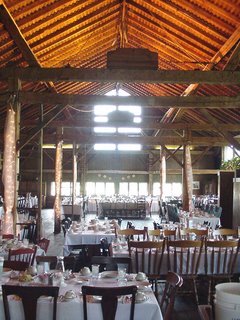Jim Beck Day at Amish Acres
Regional theatres get their personalities from the regional talent that is drawn to perform beside the guest artists, resident company, visiting directors and designers. Jim Beck, a nurse in South Bend, has been in all but three or four productions over the last twelve years. He is now moving to Lake Wales, Florida. Yesterday was his last performance of Bye Bye Birdie. The following proclamation was presented to Jim following the curtain call.
Proclamation
Jim Beck Day
WHEREAS, You have musically directed Plain and Fancy and Footloose, and filled in the orchestra pit whenever it was missing a musician; and
WHEREAS, You have played the notable roles of Jacob in the first production of Joseph and the Technicolor Dreamcoat, Lt. Brannigan in Guys and Dolls, Lloyd Christmas in The Unsinkable Molly Brown, Little Bird Soloist in Man of La Mancha, Officer Krupke and Doc in West Side Story, Reverend and Dr. Robinson in The Adventures of Tom Sawyer and Professor Sheinkopf in Fame; and performed in not one, but two productions of Fiddler on the Roof; and
WHEREAS, You were Hoagy Carmichael in Indiana Music on My Mind; and played the piano for Hoosiers & Holidays; and
WHEREAS, You cheerfully stood in the last week of Seussical: the Musical as Yertle the Turtle; and
WHEREAS, You have barked like a dog in your final performance of Bye, Bye Birdie; and
WHEREAS, You have been a driving force of positive energy, bring candy to every show and have provided surgical tape for the cast for twelve years;
NOW THEREFORE, I, Richard L. Pletcher, producer of The Round Barn Theatre at Amish Acres in Nappanee, Indiana, do hereby proclaim today, July 23, 2006, as Jim Beck Day at Amish Acres and urge all patrons to join in this observance by showing appreciation for his dedication, talent, and friendship. In witness whereof, I have hereunto set my hand and caused this seal to be affixed.
Proclamation
Jim Beck Day
WHEREAS, You have musically directed Plain and Fancy and Footloose, and filled in the orchestra pit whenever it was missing a musician; and
WHEREAS, You have played the notable roles of Jacob in the first production of Joseph and the Technicolor Dreamcoat, Lt. Brannigan in Guys and Dolls, Lloyd Christmas in The Unsinkable Molly Brown, Little Bird Soloist in Man of La Mancha, Officer Krupke and Doc in West Side Story, Reverend and Dr. Robinson in The Adventures of Tom Sawyer and Professor Sheinkopf in Fame; and performed in not one, but two productions of Fiddler on the Roof; and
WHEREAS, You were Hoagy Carmichael in Indiana Music on My Mind; and played the piano for Hoosiers & Holidays; and
WHEREAS, You cheerfully stood in the last week of Seussical: the Musical as Yertle the Turtle; and
WHEREAS, You have barked like a dog in your final performance of Bye, Bye Birdie; and
WHEREAS, You have been a driving force of positive energy, bring candy to every show and have provided surgical tape for the cast for twelve years;
NOW THEREFORE, I, Richard L. Pletcher, producer of The Round Barn Theatre at Amish Acres in Nappanee, Indiana, do hereby proclaim today, July 23, 2006, as Jim Beck Day at Amish Acres and urge all patrons to join in this observance by showing appreciation for his dedication, talent, and friendship. In witness whereof, I have hereunto set my hand and caused this seal to be affixed.



